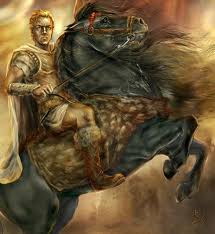Five Famous Warhorses
 1. Bucephalus 1. Bucephalus
Rider: Alexander the Great
When: 355 BC
History: Bucephalus is one of the most famous horses in history and was the mount of Alexander the Great.
History recalls him as a massive creature with a massive head, coated in black with a star on his forehead. He
was reportedly untamable by any until he met Alexander who soothed the horse by speaking to him calmly and
turning him away from his shadow. The two road into countless battles together before Bucephalus died at the
age of 30 from wounds sustained during the Battle of Hydaspes where Alexanders army defeated King Porus in 326
BC.
2. Marengo
Rider: Napoleon
When: 1799
History: Imported to France as a six year old, he was named for the Battle of Marengo during which he carried
his rider to safety. Small for a horse, only 14.1 hands, he was a steady, reliable and courageous mount capable
of great feats. Wounded eight times over his career as Napoleon's mount, he carried the man in the battles of
Austerlitz, Jena- Auerstedt, Wagram and Waterloo. He was also used to run 80 mile gallops from Valladolid to
Burgos and often completed the journey in five hours. He was captured in the Battle of Waterloo and transported
to the United Kingdom. He died at the age of 38 and his skeleton is on display in England's National Army
Museum, sans one hoof that was turned into a snuff box for the officers of the Brigade of Guards.
3. Traveller
Rider: Robert E. Lee
When: 1861
History: Traveller was purchased for use in the Civil War in 1861, but did not come into General Lee's
possession until February of 1862 when he purchased the horse he had come to call his "colt" after being
transferred to South Carolina. It was Robert E. Lee that named the horse with two L's in the British spelling,
as his prior name had been Greenbrier. Known as a horse of great stamina, he was usually a good horse and
difficult to frighten, however he was known for being nervous and spirited and at one point became so
frightened by advancing enemy troops that he pulled a grounded General Lee into a stump and broke both of his
hands. Traveller lived only a year after the death of Robert E. Lee and his remains are resting next to the Lee
Chapel at the Washington and Lee University.
4. Cincinnati
Rider: Ulysses S. Grant
When: During the Civil War
History: Always fond of horses, General Ulysses S. Grant was an excellent horseman and excelled in horsemanship
while at West Point. Cincinnati was obtained during the Civil War and was a gift from an admirer. He was a
large horse, towering at 17 hands, and quickly became a favorite of General Grant's. It was Cincinnati that
Grant chose to ride to negotiate the surrender of Robert E. Lee and it is Cincinnati that is seen in almost all
depictions of General Grant.
5. Comanche
Rider: Miles Keogh
When: The Battle of Little Bighorn
History: Part Mustang and Part Morgan, this famous gelding was wounded while fighting in Kansas. He continued
to let then owner Captain Myles Keogh fight from his back despite the arrow in his hindquarters. This earned
him the name Comanche because of his bravery. When Captain Keogh rode Comanche into the Battle of the Little
Bighorn in 1876, the entire detachment was killed, however Comanche was found two days after the battle
severely wounded. He was transported back to Fort Lincoln and nursed back to health. Once healthy, he was
retired and given to a life a leisure as a remembrance of the 7th Calvary. Comanche died in 1890 and is one of
two horses to be buried with full military honors. His remains are interred at the University of Kansas Natural
History Museum.
Related Articles
Famous Horses In Fiction
Five Famous Warhorses
5 Sports Horses Participate In
Horses in Warfare
Non-Horses
Practical Work Horses
How to Tell Your Horse's Age By Their
Teeth
How Smart Are Horses?
Gallopers
Why Are Unicorns So Popular and Could
They Really Exist?
The Role of Horses in Human
Advancement
|